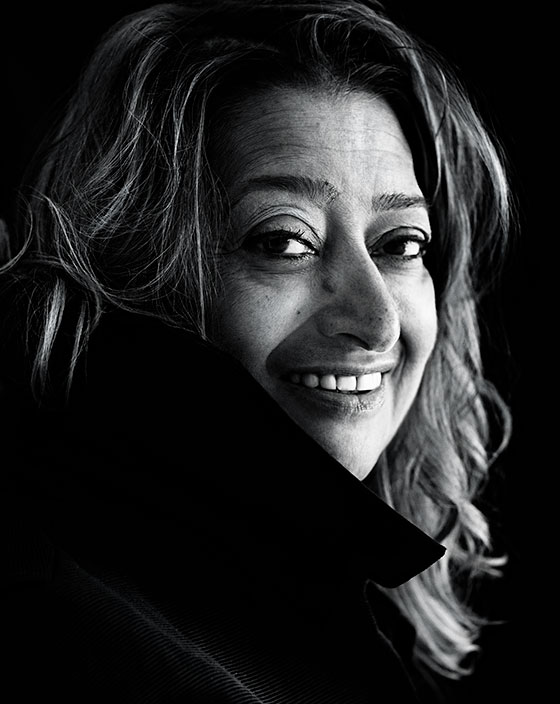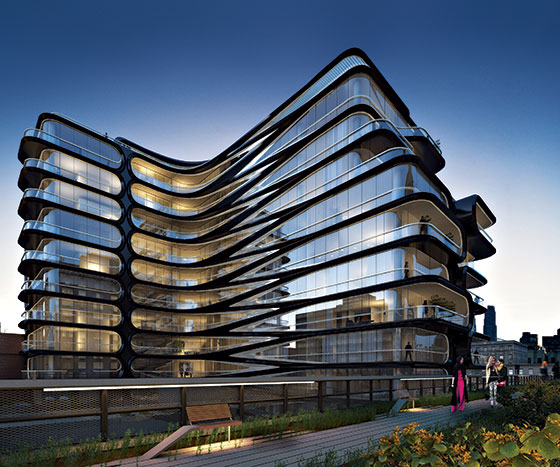
Zaha Hadid has always designed in the future tense, and her buildings—once she finally started to see them built—have conveyed an impatience with their very static buildingness, swooshing and tilting and foreshortening, straining against the present. She was born in the cosmopolitan and optimistic Baghdad of 1950, at a time when the International Style still had its utopic drive, and was educated in London under Rem Koolhaas in the seventies, before he wrote Delirious New York, his chaotic, erotic paean to ever-changing urban possibility. It was an era when the architecture world began to split: Some looked toward the traditional past, and others, like Hadid, rediscovered the early-twentieth-century Russian avant-garde, longing to build an unconstrained new world. She’s still doing that.
It’s been twenty years since her first commission, a 1993 fire station in Germany. (Now that she’s famous, it’s become a museum.) She went on to be the first woman to win the Pritzker Prize, architecture’s top honor, in 2004. Even as she became known for her sometimes volcanic personal impatience, her firm put up buildings from Cincinnati to China, Moscow to Michigan. But not, until now, in New York City.
It will be an eleven-story condo at 520 West 28th Street, next to the High Line. The site is currently occupied by a razor-wire-enclosed scrapyard, a few doors down from Scores and the Eagle leather bar. But more to the point, it’s just south of the now-inevitable supermetropolis of Hudson Yards, with which it shares an ambitious developer, the Related Companies. “I used to pass the High Line when I used to go to 22nd Street, where Max Protetch’s gallery used to be,” Hadid says over the phone from London, where she’s been suffering (impatiently) from a summer flu. “It was kind of one of those school projects: Everyone wanted to occupy the High Line.” Her firm lost out on the competition to design the High Line, to Diller Scofidio + Renfro, a similarly restless firm with a congenial sci-fi-inflected style.*
For 520, Hadid won a competition among the chic-est global architecture brands. “We jumped on it, of course,” says Patrik Schumacher, her business partner of 25 years. “We would do anything in New York.” (There was the added sweetness of beating “some old adversaries like [Norman] Foster.”) The catch? “It’s on a quite restricted site,” Hadid notes. “You can’t really go wild.” Though, when compared to the banal new Avalon apartment building across the street, hers comes off like the delightful Earth home for the weary intergalactic superrich. (Hadid is in no way luxury-avoidant: She once designed a boot-shaped house for Moscow, with a tower that looks like it could do double duty as air-traffic control, for her pal Naomi Campbell and her billionaire then-boyfriend Vladimir Doronin.) The bands of windows and curved corners at 520 also subtly echo the nearby Starrett-Lehigh Building.

On 28th Street, “when we saw the [zoning] volume, we thought, Oh my God, how are we going to do this? This is very, very constraining,” Schumacher says. “Initially, all our proposals violated the code.” Ultimately, they created two wings, one five feet higher than the other, to allow for a double-height lobby and more varied layouts. The façade gained vaguely aeronautical chevron shapes that, as the architects say, “mediate between” the staggered floors. Hadid is a fan of Mad Men, and the developer jokingly called the split-level unit the “Don Draper apartment.” Her firm is designing the interiors as well, including lobby walls for which they are experimenting with “water-jetted” marble, giving them a frozen-in-stone liquid patterning.
West Chelsea is a “fun, trendy area” which can “sustain something precious,” says Schumacher—and the building is joyously couture. That fact helps explain the near giddiness of the Related people I talk to, because the prices here will enable them, economically, to do something really cool. (When I ask about Hurricane Sandy, they reassure me that the site is just beyond the warning zone on the latest FEMA map. “We didn’t discuss that too much,” says Schumacher, calling it a “technical issue.”)
This is a small project for Hadid. The only other thing she has built in New York was a traveling art pavilion funded by Chanel, a groovy white pod that fell from low Earth orbit into Central Park in 2008. (They come in peace, so long as you have a black AmEx.) Her goals are more permanent. Last fall, the firm lost out to their nemesis Foster to design a 41-story office building at 425 Park Avenue. At the time, Hadid declared that her swooping proposal—which looked as if it might double as an enormous air purifier for midtown—had a “sleek verticality” that “breathes the very essence of the city.”
What is the essence of New York to Hadid? Her buildings’ unsettled habit of seeming on their way somewhere, their blurring the lines between public and private, indoor and out, could possibly reflect her own ungroundedness, or an idea of the future from her past. And a clear view of where we’ve stalled on the way to that future. Right now, anything as adventurous as this in a more established city neighborhood would be “impossible … they think everything will mess it up,” she laments. “You looked at the skyline after 9/11, and, okay, there’s Citicorp, but [otherwise] it’s what it was 70 years ago, more or less—Rockefeller Center, the Empire State Building. I’m waiting for the new buildings to come up.” And for now, at last, “I am absolutely thrilled to finally mark the city with my signature. I think I have designed something that fits well into the city that is very New York, and yet will also help to transform the city going forward.”
*This article has been corrected to show that Hadid’s firm lost the competition to design the High Line to Diller Scofidio + Renfro, not Hudson Yards.